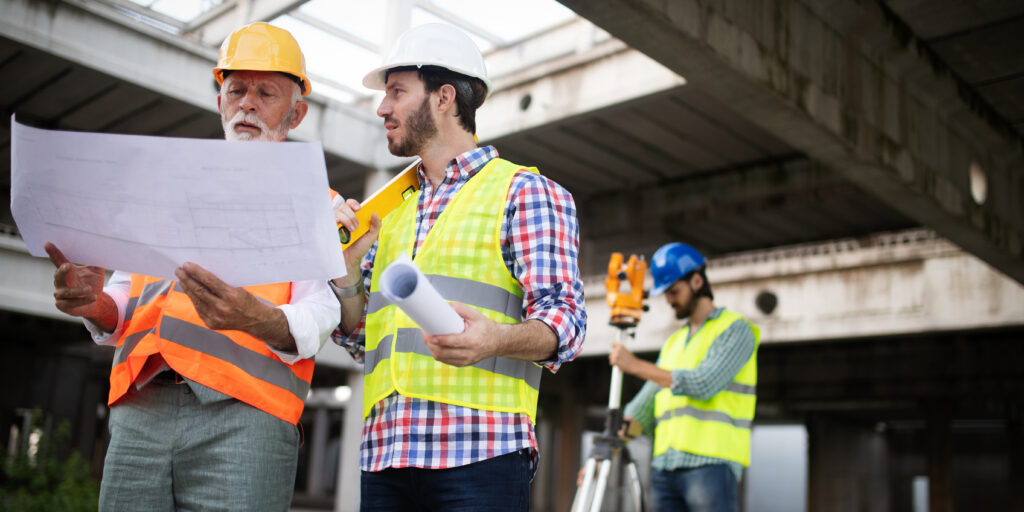— 14 min read
Everything You Need to Know About the Building Safety Act
Last Updated Mar 26, 2025
Last Updated Mar 26, 2025

The introduction of the Building Safety Act 2022 was a landmark legislation that is reshaping how we approach building safety, from initial design through to long-term management. For construction professionals, the Act represents both a challenge and an opportunity to raise standards and rebuild public trust in the wake of Grenfell.
Table of contents
What is The Building Safety Act?
The Grenfell Tower tragedy in June 2017 exposed critical flaws in the UK's building safety regime. The devastating fire claimed 72 lives and revealed systemic failures in building regulations, fire safety measures and the management of high-rise residential buildings. In the wake of such a disaster, public trust in the construction industry and building safety standards was severely shaken.
In response, the government commissioned an independent review led by Dame Judith Hackitt, which laid the groundwork for the Building Safety Act 2022. Dame Hackitt's report, "Building a Safer Future," highlighted the need for a fundamental overhaul of the regulatory system and a shift in industry culture.
The Act was introduced to:
● Enhance building safety standards across all stages of construction and occupation.
● Establish clear accountability throughout a building's lifecycle, from design to demolition.
● Empower residents with more rights and protections so their voices are heard.
● Drive lasting cultural change in the construction industry, prioritising safety over cost-cutting.
The Act received Royal Assent on 28 April 2022, marking the most significant overhaul of building safety regulations in a generation. Its impact has been felt across the entire construction sector, from architects and developers to contractors and building managers. The legislation introduces a new rules and guidelines that demands higher standards of competence, transparency and accountability from all those involved in the design, construction and management of buildings.
The Building and Safety Act takes a comprehensive approach that addresses not only the technical aspects of building safety but also the underlying cultural issues that contributed to the Grenfell tragedy. Through a culture of safety and responsibility, the Act aims to rebuild public confidence in the construction industry so that residents can feel secure in their homes.
Key components of the Act
The Building Safety Act 2022 overhauls building safety from the ground up, and it’s not just minor tweaks — it’s a complete rethink of how construction professionals, regulators, and industry stakeholders approach safety in construction. The Act established three new regulatory bodies to oversee various aspects of building safety.
Building Safety Regulator
Housed within the Health and Safety Executive (HSE), the Building Safety Regulator (BSR) now acts as the sole building control authority for higher-risk buildings(HRBs), such as high-rise residential buildings over 18 metres or seven storeys tall. The BSR is tasked with regulating the safety, design, construction, and ongoing management of these buildings to ensure they meet strict safety standards. Its responsibilities include:
- Enforcing the new building safety regime for HRBs and ensuring all relevant safety protocols are followed.
- Overseeing the safety and performance of HRBs during their design, construction, and occupation phases, including the power to issue compliance and stop notices for non-compliance.
- Promoting competence across the construction and property management sectors to ensure that those involved in building safety possess the necessary skills.
- Maintaining a register of HRBs, which building owners were required to complete by October 2023
- Collaborating with other regulatory bodies, including local authorities and the fire service, to make safety-related decisions.
For instance, if a developer is constructing a 25-storey apartment block, the BSR now fully oversees its compliance, from design to construction and occupancy. It guarantees that the building meets all fire and structural safety standards, and will stop any work that doesn’t meet these requirements until it is rectified
Shape the Future of the Built Environment at Procore's Construction Summit
Engage with construction leaders and discover the latest technology and best practices that are driving change across the industry.

National Regulator of Construction Products
The National Regulator of Construction Products ensures that construction products meet safety standards and removes unsafe products from the market. The goal here is to make sure the bricks and mortar of the industry are up to scratch. Their responsibilities include:
● Conducting market surveillance
● Enforcing regulations
● Investigating complaints
● Issuing sanctions against those who breach regulations
If a faulty fire-resistant cladding material like the one used in Grenfell were discovered, the National Regulator of Construction Products would now have the power to remove it from the market and make sure safer alternatives are used.
New Homes Ombudsman
The New Homes Ombudsman is an independent body that handles complaints related to new-build homes. It provides a route for homeowners to seek redress for issues with their properties and is the go-to place when homeowners have issues with their new builds. Key functions include:
● Investigating complaints
● Making recommendations for resolving disputes
● Requiring developers to pay compensation where appropriate
Imagine a homeowner buying a newly built house with issues like faulty plumbing or poor insulation. They can now file a complaint with the New Homes Ombudsman, who will investigate and potentially require the developer to fix the problem or offer compensation.
Higher Risk Buildings
The Act focuses on higher-risk buildings (HRBs) and introduces specific regulations, defined as:
● At least 18 metres tall or seven storeys high
● Containing at least two residential units
● Including hospitals and care homes meeting the height criteria
These buildings will be subject to more stringent safety measures and oversight throughout their lifecycle. That means extra attention at every stage, from design and construction to occupation and maintenance.
The gateway system
The Act implements a new three-stage gateway approval process for higher-risk buildings:
● Gateway 1 (Planning): Requires a fire statement to be submitted with planning applications. The goal is to take fire safety into account from day one.
● Gateway 2 (Pre-Construction): Detailed plans must be approved by the BSR before construction begins. No more breaking ground without a well-thought-out safety plan.
● Gateway 3 (Completion): The BSR must approve the completed building before occupation. It's the final hurdle before residents can move in.
The system was designed to ensure safety considerations are integrated from the earliest stages of design through to completion and occupation. It's a way of catching potential issues before they become real-world problems.
For a high-rise building, the new three-step gateway system means that fire safety must be considered from the start. For example, at Gateway 1, developers must submit a fire safety plan alongside planning permission. At Gateway 3, the Building Safety Regulator must approve the completed building before anyone can move in, ensuring all safety measures have been correctly implemented.
Golden thread of information
One of the Act's most innovative aspects is the requirement for a "golden thread" of information. Building owners and managers must maintain a digital record of building information throughout its lifecycle, including:
● Construction methods
● Materials used
● Ongoing maintenance records
● Safety system specifications
● Results of safety inspections
All critical safety information must be readily available to all relevant parties in the form of digital records, including emergency services. It promotes transparency and accountability by creating a clear audit trail of decisions and actions related to building safety.
In practice, this means that if a fire were to occur, fire departments would have immediate access to the building’s digital 'golden thread' of information, allowing them to see details like fire-resistant materials used and the building’s structural layout, which could speed up rescue efforts.
Duty holder roles
The Act creates new duty holder roles to provide clear accountability and improving safety at every phase of a building's lifecycle, from design through to occupation and maintenance.
Specific responsibilities include:
● Client: Overall responsibility for compliance with building regulations and safety standards.
● Principal designer: Oversees design work and ensures building regulation compliance throughout the design process.
● Principal Contractor: Manages construction work and ensures compliance with safety standards during the build.
● Building safety manager: A new role responsible for the day-to-day management of fire and structural safety in higher-risk buildings.
These roles create clear lines of accountability and guarantee that safety considerations are prioritised at every stage of a building's lifecycle. Everyone knows their part in keeping buildings safe.
For example, in the case of a 10-storey residential building, the principal contractor would be responsible for making sure all workers follow safety protocols during construction. Meanwhile, the building safety manager would oversee the day-to-day safety management once the building is occupied, addressing issues like fire door inspections and alarm testing.
Competence requirements
The Act places a strong emphasis on competence for all professionals involved in building work. Duty holders must demonstrate they have the skills, knowledge and experience to carry out their roles effectively. It’s a requirement that extends to the entire supply chain, from designers and contractors to installers and maintenance workers.
Resident engagement
Recognising the important role residents play in building safety, the Act mandates improved communication between building owners and occupants. Building owners must establish clear communication channels with residents and provide them with safety-related information, including:
● Fire safety measures
● Evacuation procedures
● How to report safety concerns
● Regular updates on building safety
Residents should feel empowered and receive the information they need to play an active role in their own safety. It's a two-way street, with residents encouraged to report concerns and building owners required to listen and act.
A real-world scenario might involve a group of tenants in a high-rise flat receiving regular updates from their building manager about upcoming fire alarm tests and safety inspections, while also having a clear process to report any safety concerns they may notice.
Industry Impact: challenges and opportunities
Since its inception, the Building Safety Act 2022 has presented both challenges and opportunities for the construction industry:
Increased accountability
The Act extends the limitation period for claims under the Defective Premises Act 1972 to 30 years retrospectively and 15 years prospectively. It’s a significant increase in potential legal responsibility for construction professionals, emphasising the need for highlighting and checking quality control and documentation.
Enhanced safety standards
Companies must demonstrate compliance with stricter safety standards at every stage, from initial design to final handover. Updates may be required to existing processes and the adoption of new technologies.
Professional competence
The Act's emphasis on competence means construction professionals at all levels need to make sure they have the necessary skills and qualifications. As a result, we may see an increase to investment in training and development programmes across the industry.
Digital record-keeping
The requirement for a "golden thread" of information necessitates improved digital record-keeping practices. Construction companies will need to invest in strong digital systems to capture, store and manage building information throughout its lifecycle.
Product safety
The establishment of the National Regulator of Construction Products will lead to stricter standards for construction materials. Suppliers and manufacturers will need to ensure their products meet these enhanced safety requirements.
Costs and timelines
Additional regulatory requirements have led to increased costs and longer project timelines, particularly for higher-risk buildings. Companies will need to factor these considerations into their project planning and budgeting processes.
Insurance and risk management
The extended liability periods may necessitate a reassessment of insurance coverage and risk management strategies. Construction companies are typically working more closely with insurance providers to ensure adequate coverage for potential claims arising from past projects.
A company that constructed a building 20 years ago could now face legal claims if safety defects related to fire or structural safety are discovered, as the liability period has been extended to 30 years.
Being well prepared for compliance
To be well prepared when it comes to the Building Safety Act, construction companies should consider the following steps:
Conduct a thorough review of current practices and processes to identify areas needing improvement to meet the new requirements. This is more about digging deep into every aspect of your operations than it is giving it a quick once-over.
Invest in training and development programmes so that all staff have the necessary competencies for their roles. You might need to bring in external experts or develop in-house training modules.
Implement digital systems for capturing and managing building information throughout the project lifecycle.
Review and update quality control processes to ensure compliance with enhanced safety standards. This could involve more frequent inspections or implementing new testing procedures.
Assess current insurance coverage and risk management strategies in light of the extended liability periods. Don't wait until you're facing a claim to realise your coverage isn't adequate.
Engage with industry bodies and regulators to stay informed about guidance and best practices as they evolve. The landscape is still changing quickly. Make sure you're not left behind.
Consider appointing a dedicated Building Safety Manager to oversee compliance with the new regulations, especially when it comes to higher-risk buildings.
Review and update contracts and agreements to reflect the new responsibilities and liabilities introduced by the Act. This might involve tough conversations with clients and subcontractors, but it's essential to get it right.
Develop a culture of safety awareness throughout your organisation. Make safety a core value that informs every decision.
Implementation timeline
The Building Safety Act was implemented in phases to allow the industry time to adapt:
● April 2022: Royal Assent received
● October 2023: Registration of existing occupied higher-risk buildings required
● April 2024: Full implementation of the new regulatory regime expected
This phased approach provided a window of opportunity for construction companies to prepare for the new requirements and make necessary adjustments to their practices.
The Building Safety Act represents a significant step towards a safer built environment, but it's likely just the beginning of a longer journey. As the industry adapts to these new requirements, we can expect to see:
● Continued evolution of building safety regulations
● Increased use of technology in building design, construction and management
● Greater emphasis on sustainability alongside safety
● More collaborative approaches to building design and construction
● Ongoing improvements in quality and safety management practices
The construction industry must remain agile and responsive to these changing standards and expectations. Companies that embrace innovation and prioritise safety will be best positioned to thrive in this new landscape.
What does the future hold?
Looking forward, we might see the emergence of new roles and specialisations within the industry. For instance, building safety consultants or digital twin specialists could become integral parts of project teams. The integration of artificial intelligence and machine learning in building management systems could revolutionise how we monitor and maintain building safety over time.
Moreover, the principles of the Building Safety Act could extend beyond their current scope. While the Act primarily focuses on higher-risk buildings, its approach to safety and accountability could influence practices across all types of construction projects. As a result, we could see a broader cultural shift in the industry, where safety becomes the key consideration in every decision.
Setting the stage
The Building Safety Act 2022 marked an important moment for the UK construction industry. It sets the stage for a safer, more responsible built environment. While challenges lie ahead, the Act offers an opportunity to rebuild public trust and elevate industry standards. Embracing these changes will be key to success in this new era of enhanced building safety.
Shaping the future
Leveraging these resources and embracing the changes brought about by the Building Safety Act means construction professionals can play a vital role in shaping a safer, more resilient built environment for future generations.
Categories:
Tags:
Written by
Nicholas Dunbar
29 articles
Nick Dunbar oversees the creation and management of UK and Ireland educational content at Procore. Previously, he worked as a sustainability writer at the Building Research Establishment and served as a sustainability consultant within the built environment sector. Nick holds degrees in industrial sustainability and environmental sciences and lives in Camden, London.
View profileExplore more helpful resources

Construction Document Software: Essential Tools for Project Success
Construction projects depend on extensive paperwork, including designs, contracts, RFIs, and compliance records. A single misplaced document can trigger delays, disputes, or compliance violations. Despite increasing digital adoption, many teams...

Construction Planning: A Guide to Successful Project Execution
Every successful construction project begins long before the first brick is laid. Indeed, behind each structure – whether a towering skyscraper or complex infrastructure project – lies a carefully crafted...

Leveraging Analytics for Better Financial Forecasting in Construction
Financial forecasting is a difficult task in any industry. In construction, where companies need to manage volatile material costs, labour shortages and variation orders on a daily basis, fluctuations in...

Strategies to Prevent Rework: The Importance of Clear Instructions
In construction, “rework” is the dreaded process of redoing tasks due to mistakes, quality issues, or safety concerns. This unnecessary work drains budgets through wasted materials and labour while causing...